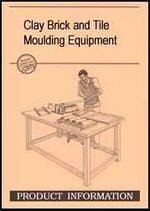Moulding equipment[edit | edit source]
There are basically five types of moulding equipment:
Wooden moulds: the clay is formed into a clot, thrown into the mould, and the excess cut off. There are two traditional techniques for releasing the brick from the mould:
a. the slop-moulding method, by which the mould is kept wet and the clay is mixed with more water, and
b. the sand-moulding method, by which the clot is rolled in sand to prevent the clay from sticking to the mould. Bricks made by slop-moulding are vulnerable to slumping and distortion, while sand-moulding produces firmer, well-shaped bricks, due to a little less water in the clay.
Moulding tables: the moulding is done in the same way as with simple wooden moulds, whereby the bricks are ejected by means of a foot-operated lever; table moulds require less effort, produce more accurately shaped bricks, and achieve uniform production and higher outputs.
Manual presses: the moulding and fuming out operations are carried out by a machine which is operated manually.
Motorized presses: the moulding and fuming out operations (mechanical or hydraulic) are carried out by a machine which is power driven.
Extruders (hand-operated or fully automatic): fed with wet clay and extruded continuously under great pressure through a die (mouth piece producing a uniform cross-section) and cut with a wire-cutter into components of required lengths.
Industrial production units: these production units cannot be transported, but the entire process is automated. These units are not included in the Product Information.
Corresponding to the great diversity of moulding equipment, the prices for machines other than those for industrial production, can be up to 10 000 US The following (extremely generalized) compilation of the respective advantages and problems clearly shows that each system caters for a certain range of needs and thus has a valid place to fill.
Advantages of manually operated equipment
+ Low capital and operational costs.
+ Low weight (easy to transport on wheelbarrows or bullock-carts).
+ Small size, thus little storage space required.
+ Simple to use, even for unskilled workers.
+ Apart from cleaning the mould and lubrication of moving parts, low maintenance requirements.
+ Possibility of repairs in local workshops, no special spare parts required.
+ No additional costs of energy.
+ No time loss due to failure of energy supply.
Problems of manually operated equipment:
- Low rate of production per machine, thus requiring a number of machines to achieve a reasonable output.
- Tiring operation; thus, in the course of a series tendency of gradual drop in quality and uniformity of products, if the work is done only by one person.
Advantages of automatic, motor-driven machines:
+ High rate of production .
+ Good quality products (optimum dimensional uniformity, stability of edges).
+ Reduction of manual work, thus saving costs, where wages are high.
Problems of automatic, motor-driven machines:
- High capital and operational costs.
- Usually very heavy, requiring powerful lifting gear and vehicles for transportation, ie transports are troublesome and expensive.
- Large size, requiring large working area.
- Necessity of skilled labour for operation of machines.
- Need of continuous supplies of large quantides of raw material.
- Maintenance requirements (eg some hydraulic machines) rather complex.
- Requirement of specialists for repairs; spare parts possibly expensive and difficult to get, or only after long delivery time.
- Dependancy on adequate energy supply. - In the case of extruders:
- need for very careful clay preparation in terms of clay type and proportion, particle size and moisture content,
- special know-how and skill in handling the dies (mouth pieces), and
- wearing of the auger and other parts.
Summary
The above list of advantages and disadvantages of the different categories of clay brick and tile moulding equipment lead to the following conclusions:
Small, manually operated equipment are best suited:
- in case of limited capital resources;
- for projects in remote areas, or those that lack the necessary infrastructure;
- in small workshops, with limited working space;
- where entrepreneurs, with a small capital base and a team of unskilled workers, produce fired clay products for the local market, where the demand is relatively low;
Powered, high capacity machines are advantageous:
- where sufficient financial resources are available;
- in cases where high production rates are needed and there is a high demand over a long period;
- for projects that specify better material qualities;
- in working environments with sufficient energy supply, as well as maintenance and repair facilities;
- in cases, where labour is expensive or not easily available;
- where management skills are available
- to organize the supply of raw material,
- to coordinate the complex production process,
- to market the products on a large scale, ensuring a continuously high output rate.
A combination of both categories of machines would allow the producer to adjust the daily output rates according to current demands, and also permit continuity of manual production in case of breakdown of the automatic machines.
